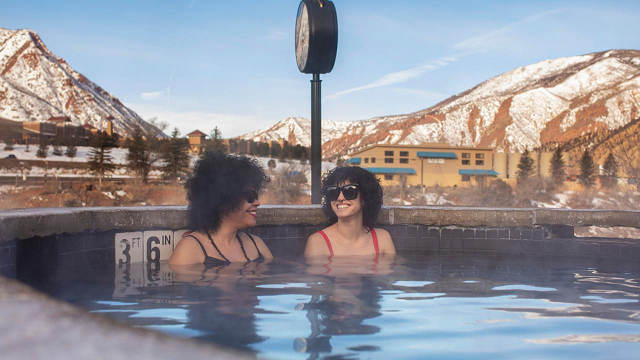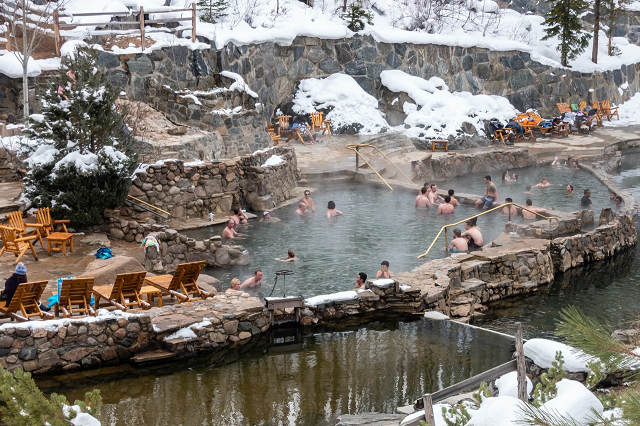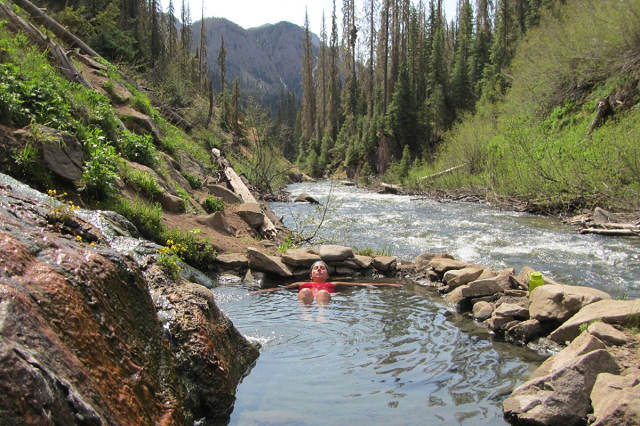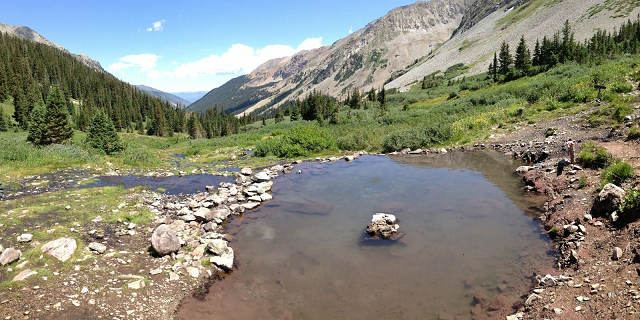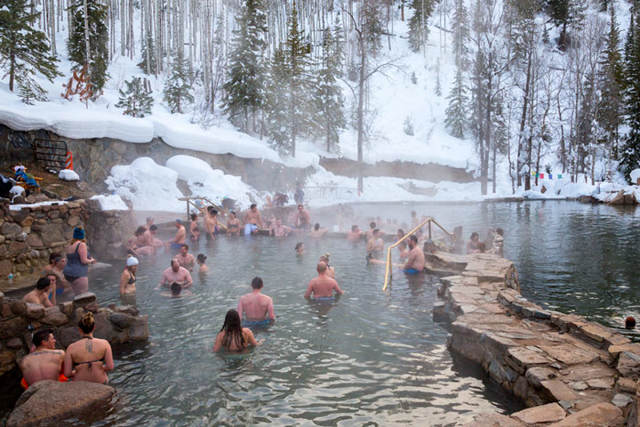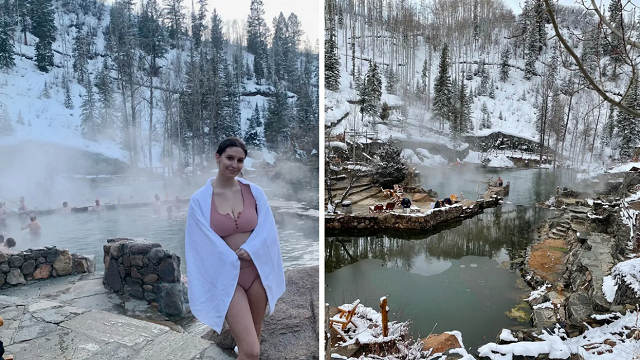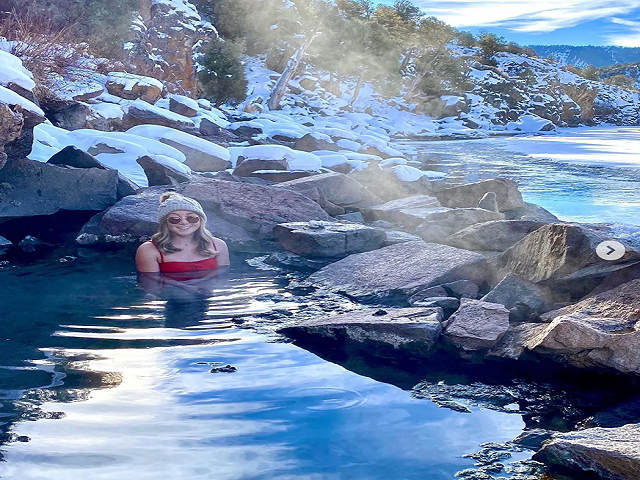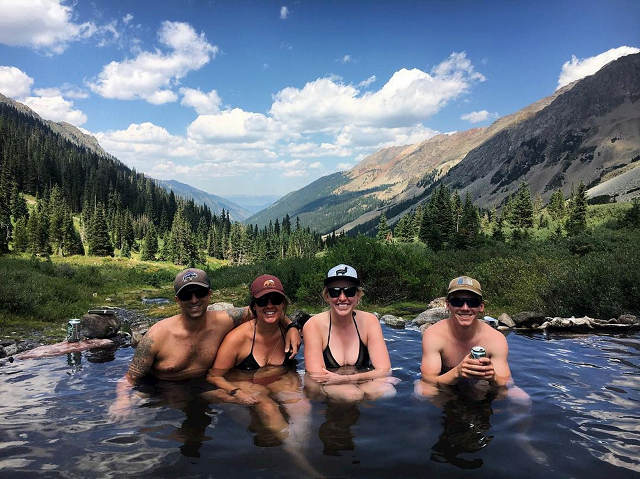Colorado’s Natural Hot Springs – Welcome to the enchanting world of Colorado’s natural hot springs! Nestled amidst the stunning landscapes of the Rocky Mountains, Colorado boasts an impressive collection of geothermal wonders that have been drawing visitors for centuries. The allure of these natural hot springs lies not only in their inviting warmth but also in the therapeutic benefits they offer to the body and mind.
In this comprehensive guide, we will delve into the captivating history, geological wonders, and unique features of Colorado’s hot springs. Whether you’re an avid adventurer seeking a rejuvenating soak after a day of exploration or a wellness enthusiast in pursuit of the healing properties of mineral-rich waters, Colorado’s hot springs offer something truly special for everyone.
Beyond the physical and mental advantages of hot springs, we will also explore the cultural significance of these geothermal treasures, as they have played a crucial role in the lives of indigenous communities and early settlers. Moreover, we’ll examine the delicate balance between hot springs tourism and environmental preservation, as we strive to ensure these natural wonders remain accessible for generations to come.
Join us on this immersive journey as we uncover the hidden gems, seasonal delights, and captivating stories that make Colorado’s natural hot springs an experience like no other. Whether you’re planning a relaxing getaway or seeking adventure amid picturesque landscapes, this guide will equip you with all the information you need for an unforgettable hot springs escapade in the magnificent state of Colorado. So, grab your swimsuit, embrace the therapeutic waters, and let the magic of the hot springs envelop you in their warm embrace!
History of Colorado’s Hot Springs
A. Indigenous Use and Cultural Significance
Long before Colorado became a popular destination for hot springs enthusiasts, these geothermal wonders held deep significance for the indigenous peoples of the region. Native American tribes revered hot springs for their healing properties and considered them sacred places. The warm waters were believed to possess spiritual energy, and tribal communities often used them for ceremonial rituals and therapeutic purposes.
Exploring the historical connection between hot springs and indigenous cultures allows us to gain a profound appreciation for the cultural heritage that continues to thrive today. Understanding the traditions and practices associated with these natural marvels offers a richer perspective on the role hot springs have played in shaping Colorado’s history.
B. Early Settlers’ Discoveries and Exploitation
The discovery of hot springs by European settlers in Colorado dates back to the early 19th century. As pioneers ventured westward, they stumbled upon these steamy oases tucked away in the rugged wilderness. Recognizing the potential commercial value, some entrepreneurs established hot spring resorts to cater to travelers seeking relaxation and rejuvenation.
During the late 1800s and early 1900s, hot springs experienced a surge in popularity as health resorts, attracting visitors from across the country seeking relief from various ailments. The development of railroads and improved infrastructure further facilitated access to these natural havens, transforming them into sought-after tourist destinations.
C. Development of Hot Spring Resorts and Tourism
The 20th century witnessed a rapid growth in hot spring resorts throughout Colorado. From rustic cabins to luxurious lodges, entrepreneurs capitalized on the allure of hot springs, creating an array of accommodations to cater to different preferences and budgets.
With the rise of tourism, hot springs became not only places of healing but also hubs of entertainment and social gatherings. Visitors enjoyed various recreational activities, including dancing, live music, and social events. The charm of the hot spring resorts soon became an integral part of Colorado’s cultural fabric.
Despite facing challenges like economic downturns and environmental concerns, many hot spring resorts persevered, maintaining their historical significance while embracing modern amenities to cater to a contemporary audience. Today, these resorts continue to be popular destinations, where travelers can immerse themselves in the rich history and natural beauty of Colorado’s hot springs.
Historical Significance of Colorado’s Hot Springs
Colorado’s hot springs hold a profound historical significance that dates back centuries, well before the state became a popular tourist destination. These natural geothermal wonders have been revered by various cultures for their healing properties, spiritual significance, and natural beauty. Exploring the historical context of Colorado’s hot springs provides us with a deeper understanding of their cultural importance and enduring appeal.
- Native American Use and Spiritual Beliefs:
- Native American tribes, including the Ute, Arapaho, and Cheyenne, inhabited the land now known as Colorado for thousands of years. These indigenous communities recognized the healing potential of hot springs and often regarded them as sacred places. Hot springs were used for medicinal purposes, offering relief from ailments such as arthritis, rheumatism, and skin conditions.
- Additionally, many tribes believed that hot springs were conduits to the spirit world, places where they could communicate with ancestors and seek spiritual guidance. Rituals and ceremonies were performed at these sites to honor the Earth and its natural gifts.
- European Settlers’ Discovery and Utilization:
- The arrival of European settlers in the 18th and 19th centuries led to the widespread exploration of the American West, including the discovery of Colorado’s hot springs. Early explorers were drawn to these thermal waters and recognized their potential for healing and relaxation.
- As word spread about the natural hot springs, entrepreneurs and developers established resorts and bathhouses around them. These establishments attracted visitors seeking the therapeutic benefits of the mineral-rich waters, setting the foundation for Colorado’s hot springs tourism industry.
- Boom in Hot Springs Tourism:
- During the late 19th and early 20th centuries, hot springs resorts flourished across Colorado. The state’s reputation as a wellness destination grew, and travelers from across the country flocked to experience the healing properties of the geothermal waters.
- The elegant architecture of the era’s grand resorts, some of which still stand today, reflects the luxurious and opulent atmosphere that surrounded these hot spring destinations. Resorts like Glenwood Springs and Steamboat Springs gained prominence and became renowned wellness retreats.
- Hot Springs in Medicine and Industry:
- Beyond their recreational and spiritual significance, Colorado’s hot springs have played essential roles in various fields. Medicinal practitioners incorporated hot springs therapy into their treatments, and many doctors recommended patients to “take the waters” for specific ailments.
- In the early 20th century, some hot springs were utilized for industrial purposes, generating geothermal energy for greenhouses, spas, and even power generation.
- Preservation and Environmental Awareness:
- In more recent times, there has been an increasing awareness of the need to preserve these natural hot springs and their surrounding ecosystems. Conservation efforts and responsible tourism practices are being promoted to protect the delicate balance of these geothermal wonders.
- Native American communities continue to advocate for the cultural significance and protection of these sites, ensuring that their spiritual and healing heritage is respected.
The historical significance of Colorado’s hot springs remains an integral part of the state’s identity and continues to attract visitors seeking not only relaxation and rejuvenation but also a connection to the rich tapestry of human history that these natural wonders represent.
Planning Your Hot Springs Adventure
A visit to Colorado’s natural hot springs promises an unforgettable adventure filled with relaxation, natural beauty, and therapeutic benefits. To ensure a smooth and enjoyable trip, careful planning and preparation are essential. Here’s a step-by-step guide to help you plan your hot springs adventure:
- Research Hot Springs Locations:
- Explore the various natural hot springs across Colorado and choose the ones that align with your preferences and travel itinerary.
- Consider factors such as accessibility, distance from your accommodation, and the overall experience each hot spring offers.
- Determine the Best Time to Visit:
- While some hot springs can be enjoyed year-round, others are best experienced during specific seasons.
- Check the weather conditions and any seasonal closures before finalizing your trip.
- Obtain Necessary Permits and Reservations:
- Some hot springs require permits or reservations for entry, especially if they have limited capacity to maintain their natural environment.
- Make the necessary arrangements in advance to secure your spot.
- Pack Accordingly:
- Pack appropriate clothing, including swimwear, towels, and a change of clothes.
- Don’t forget essentials like sunscreen, a hat, and comfortable shoes for exploring nearby areas.
- Plan for Safety:
- Ensure your safety during the hot springs visit by informing someone about your itinerary and expected return time.
- If you’re going on a remote or backcountry adventure, bring a first aid kit and any necessary emergency equipment.
- Check Facilities and Amenities:
- Some hot springs have on-site amenities such as changing rooms, showers, and even cafes or picnic areas.
- Research the available facilities to know what to expect during your visit.
- Respect Nature and Leave No Trace:
- Follow the principles of Leave No Trace to protect the environment and preserve the natural beauty of the hot springs and their surroundings.
- Refrain from leaving any waste or litter, and avoid damaging plants or wildlife.
- Know the Rules and Etiquette:
- Familiarize yourself with the specific rules and etiquette of each hot spring location.
- Respect the privacy of other visitors and adhere to any posted guidelines.
- Consider Nearby Attractions:
- Many hot springs are located near other scenic spots or recreational areas worth exploring.
- Plan additional activities such as hiking, sightseeing, or visiting nearby towns to make the most of your trip.
- Check for Local Events or Festivals:
- Research if there are any special events or festivals happening during your visit, as they could add to the overall experience.
- Prepare for Photography:
- Capture the beauty of the hot springs and the surrounding landscapes by bringing along a camera or smartphone.
- Respect Wildlife and Native Cultures:
- When visiting hot springs located in wilderness areas, be mindful of the wildlife and avoid disturbing their habitats.
- If the hot springs have cultural significance to Native American communities, show respect and refrain from any disrespectful actions.
By following these planning steps, you’ll be well-prepared for an enriching and memorable hot springs adventure in the captivating state of Colorado. Remember to immerse yourself fully in the healing waters and embrace the tranquility that nature’s geothermal wonders offer.
Health Benefits of Hot Springs
Colorado’s natural hot springs have long been celebrated for their therapeutic properties and the wide range of health benefits they offer. From soothing muscle aches to promoting mental relaxation, these geothermal wonders provide a holistic wellness experience. Let’s explore the various health benefits of immersing yourself in the warm, mineral-rich waters of Colorado’s hot springs:
- Pain Relief and Muscle Relaxation:
- The warm temperature of hot springs water helps to dilate blood vessels, increasing blood flow to sore or injured muscles.
- The high mineral content, including magnesium and sulfur, can alleviate muscle pain and promote relaxation, making hot springs an ideal natural remedy for muscle tension and stiffness.
- Stress Reduction and Improved Sleep:
- The tranquil atmosphere and warm waters of hot springs induce a sense of calm and relaxation, reducing stress and anxiety.
- Soaking in hot springs can lead to better sleep quality by easing the mind and body, making it an excellent way to unwind and improve overall sleep patterns.
- Skin Health and Rejuvenation:
- The minerals present in hot springs water, such as silica and sulfur, have skin-nourishing properties.
- These minerals can help improve skin elasticity, promote collagen production, and alleviate certain skin conditions, leaving the skin looking and feeling revitalized.
- Detoxification and Improved Circulation:
- Soaking in hot springs stimulates sweating, which aids in the elimination of toxins and impurities from the body.
- The warm water also dilates blood vessels, enhancing circulation and promoting better nutrient delivery to cells while removing waste products.
- Respiratory Benefits:
- The steam and mineral-rich air of hot springs can provide relief for respiratory conditions like asthma and bronchitis.
- Inhaling the steam can help open up airways, ease breathing, and reduce symptoms of congestion.
- Joint and Arthritis Relief:
- The buoyancy of hot springs water reduces pressure on joints, providing relief for individuals with arthritis and other joint-related issues.
- The warmth and minerals also promote joint mobility and flexibility, easing discomfort and improving range of motion.
- Boosted Immune System:
- The minerals found in hot springs water, such as selenium and zinc, can contribute to a stronger immune system.
- Regular hot springs visits may help the body fight off infections and illnesses more effectively.
- Improved Cardiovascular Health:
- The heat from hot springs can have a positive effect on the cardiovascular system by improving blood flow and reducing blood pressure.
- This can lead to a healthier heart and reduced risk of cardiovascular diseases.
- Pain Management for Chronic Conditions:
- Hot springs therapy is often recommended as a complementary treatment for chronic conditions such as fibromyalgia and rheumatoid arthritis.
- The combination of warmth, buoyancy, and mineral content can provide pain relief and improved quality of life for those with chronic pain.
- Mental Wellness and Stress Reduction:
- Soaking in hot springs allows for a meditative and introspective experience, promoting mental well-being and mindfulness.
- The tranquil setting and natural surroundings help reduce stress and promote a sense of inner peace.
Before embarking on a hot springs adventure, it’s essential to consider individual health conditions and consult with a healthcare professional if necessary. With proper planning and responsible enjoyment, immersing yourself in the healing waters of Colorado’s hot springs can be a truly rejuvenating and health-enhancing experience.
Soaking Etiquette and Responsible Tourism
While visiting Colorado’s natural hot springs can be a delightful experience, it’s crucial to practice proper soaking etiquette and responsible tourism to ensure the preservation and respect for these precious natural wonders. Being mindful of the environment and fellow visitors enhances everyone’s enjoyment and contributes to the sustainability of these geothermal treasures. Here are some guidelines for responsible hot springs soaking and tourism:
- Respect posted rules and guidelines:
- Many hot springs have specific rules posted on-site to protect the environment and ensure the safety of visitors. Read and adhere to these rules during your visit.
- Practice Leave No Trace principles:
- Hot springs are delicate ecosystems. Avoid leaving any trace of your visit, such as trash or litter. Dispose of waste properly and consider packing out any trash you bring with you.
- Keep hot springs clean:
- Avoid using soaps, shampoos, or any chemical products in or near the hot springs. These substances can harm the delicate balance of the water and its surroundings.
- Respect other visitors’ privacy:
- Hot springs often attract visitors seeking relaxation and solitude. Respect their space and avoid unnecessary noise or disturbances.
- Be mindful of nudity:
- Some hot springs have clothing-optional policies. If you are unsure, observe the behavior of other visitors before deciding whether to wear swimwear or not.
- Control noise levels:
- Keep voices low and avoid playing loud music. The serene ambiance of hot springs is best enjoyed in a peaceful atmosphere.
- Observe wildlife from a distance:
- If you encounter any wildlife during your visit, maintain a safe distance and avoid feeding or disturbing them.
- Stick to designated paths and trails:
- Follow established paths to minimize the impact on vegetation and wildlife habitats surrounding the hot springs.
- Respect cultural and historical sites:
- Some hot springs may have cultural or historical significance to indigenous communities or early settlers. Treat these sites with reverence and avoid damaging or removing any artifacts.
- Use caution around hot springs:
- Hot springs water can be extremely hot and cause burns. Test the water temperature before fully immersing yourself and avoid submerging your head in the water.
- Follow fire regulations:
- If you plan to have a campfire, adhere to local fire regulations and use established fire pits if available.
- Camp responsibly:
- If camping near hot springs is allowed, choose a designated campsite and follow camping guidelines to minimize your impact on the environment.
- Educate yourself and others:
- Learn about the geological and cultural significance of the hot springs and share this knowledge with others to foster a deeper appreciation for these natural wonders.
By embracing responsible tourism and soaking etiquette, you can contribute to the preservation of Colorado’s natural hot springs and ensure that future generations can enjoy their splendor. Let’s work together to protect these geothermal marvels and the surrounding ecosystems while creating memorable and respectful experiences for all visitors.
Exploring the Surrounding Areas
Colorado’s natural hot springs are often located in picturesque settings, surrounded by stunning landscapes and exciting attractions. Exploring the surrounding areas allows you to make the most of your hot springs adventure and discover the diverse beauty that Colorado has to offer. Here are some captivating attractions and activities near the hot springs that you won’t want to miss:
- Hiking and Nature Trails:
- Many hot springs are nestled in or near national parks, forests, or wilderness areas, offering fantastic hiking opportunities.
- Explore scenic trails that lead to breathtaking vistas, waterfalls, and unique geological formations.
- Wildlife Viewing:
- Keep an eye out for native wildlife while exploring the surrounding areas. Colorado is home to diverse wildlife, including elk, deer, bighorn sheep, and various bird species.
- Wildlife viewing can be especially rewarding during early mornings and evenings.
- Scenic Drives:
- Embark on scenic drives that take you through picturesque mountain passes, charming towns, and awe-inspiring viewpoints.
- Some hot springs can be accessed by scenic byways, providing a scenic journey to your destination.
- Photography Opportunities:
- Capture the beauty of Colorado’s landscapes and the unique geothermal features of the hot springs through photography.
- Sunrise and sunset are particularly magical times for capturing stunning shots.
- Historic Sites and Museums:
- Learn about the rich history of the area by visiting local museums and historic sites.
- Discover the stories of early settlers, indigenous cultures, and the pioneers who once frequented these hot springs.
- Local Cuisine and Dining:
- Enjoy the culinary delights of the region by trying local restaurants and eateries.
- Many towns near hot springs offer delicious dishes featuring regional produce and flavors.
- Adventures and Thrills:
- If you’re seeking adrenaline-pumping experiences, consider nearby adventure activities like white-water rafting, zip-lining, or rock climbing.
- Thrilling activities can complement the relaxation and tranquility of hot springs soaking.
- Cultural Events and Festivals:
- Check local event calendars for festivals, art exhibits, or live performances taking place during your visit.
- Participating in cultural events allows you to immerse yourself in the vibrant local culture.
- Stargazing and Night Skies:
- Some hot springs are located in areas with minimal light pollution, making them ideal for stargazing.
- Witness the breathtaking night sky and the wonder of celestial bodies.
- Relaxing in Nature:
- Simply take the time to relax in the natural surroundings of the hot springs. Enjoy the sound of flowing water and the peace that nature provides.
- Geological Wonders:
- Explore nearby geological attractions such as canyons, rock formations, and geysers that showcase the diverse geology of the region.
- Yoga and Wellness Retreats:
- Some hot springs resorts offer yoga classes or wellness retreats, combining the benefits of hot springs with holistic practices for the mind and body.
Whether you’re a nature enthusiast, adventure seeker, or cultural explorer, the surrounding areas of Colorado’s hot springs have something to offer everyone. Take the time to immerse yourself fully in the beauty and diversity of the region, creating cherished memories and experiences to last a lifetime.
Colorado’s Natural Hot Springs (FAQs)
As you plan your Colorado hot springs adventure, you may have some common questions in mind. Here are answers to frequently asked questions to help you prepare for an incredible and memorable experience:
- What are the best times to visit hot springs in Colorado?
- Hot springs can be enjoyed year-round, but spring and fall typically offer pleasant weather for outdoor soaking. Winter visits provide a cozy and magical experience, while summer allows for refreshing dips in the geothermal waters.
- Are natural hot springs safe for children and families?
- Many hot springs are safe for families, but it’s essential to supervise children closely, especially near water sources. Check each hot spring’s policies and guidelines to ensure a family-friendly environment.
- Can I camp near the hot springs during my visit?
- Camping near hot springs is allowed in some areas, while others may have specific regulations or designated campsites nearby. Research the specific hot springs you plan to visit for camping options.
- Are there hot springs suitable for solo traveler?
- Yes, there are hot springs that cater to solo travelers seeking a peaceful and rejuvenating experience. Some hot springs even offer lodging options perfect for solo explorers.
- What are the health benefits of soaking in hot springs?
- Soaking in hot springs offers numerous health benefits, including pain relief, muscle relaxation, stress reduction, improved skin health, and enhanced respiratory health. The mineral-rich waters can promote overall well-being and relaxation.
- How do I find hot springs that are less crowded?
- Research lesser-known hot springs or visit during weekdays or shoulder seasons to avoid peak crowds. Early morning or late afternoon visits can also provide a more tranquil experience.
- What type of clothing should I wear when visiting hot springs?
- Most hot springs allow swimwear, but some may have clothing-optional policies. Wear comfortable swimwear that you don’t mind getting wet and consider bringing a towel or robe for after your soak.
- Are there any hot springs with specific water temperatures?
- Yes, some hot springs have varying water temperatures, from very hot to comfortably warm. Research the specific hot spring you plan to visit to find the ideal water temperature for your preference.
- How deep are the hot springs, and is swimming allowed?
- Hot springs can vary in depth, with some areas suitable for soaking while others may be shallow or unsuitable for swimming. Always check on-site signage and adhere to safety guidelines provided.
- Can I bring my pet to the hot springs?
- While some hot springs permit pets, others may have restrictions or prohibit them altogether. Always check the hot spring’s pet policy before bringing your furry friend.
Remember that each hot spring may have unique rules and regulations, so it’s essential to research and plan accordingly before embarking on your hot springs adventure. With these FAQs addressed, you can better prepare for a relaxing and enjoyable experience surrounded by Colorado’s natural geothermal wonders.
Conclusion
Embarking on a hot springs adventure in Colorado promises a journey of relaxation, rejuvenation, and exploration amid nature’s geothermal wonders. From the historical significance of these natural hot springs to the health benefits they offer, there’s much to discover and appreciate in this serene landscape.
Colorado’s top natural hot springs beckon with their mineral-rich waters, providing relief for tired muscles, promoting mental wellness, and enhancing overall well-being. Whether you seek solace in the tranquility of solo soaking or plan a family adventure, these geothermal oases offer something for everyone.
However, as we immerse ourselves in the healing embrace of hot springs, it’s crucial to practice responsible tourism and respect the delicate ecosystems that surround them. By adhering to soaking etiquette, following posted rules, and embracing Leave No Trace principles, we can help preserve these natural treasures for future generations to enjoy.
Beyond the hot springs, the enchanting surroundings invite exploration. Hiking trails reveal breathtaking vistas, and nearby attractions offer cultural enrichment and thrilling experiences. Whether you wish to unwind and stargaze or seek adrenaline-pumping adventures, the surrounding areas of Colorado’s hot springs have an array of activities to fulfill your desires.
As you plan your hot springs escapade, remember to consider each hot spring’s unique features, accessibility, and seasonal variations. Be mindful of the health benefits they offer, such as pain relief, stress reduction, and improved skin health, making your visit a truly rejuvenating experience.
In conclusion, a hot springs adventure in Colorado is a blissful union of relaxation, natural beauty, and wellness. By respecting the environment, practicing responsible tourism, and embracing the tranquility of these geothermal oases, you’ll create cherished memories and connect with the spirit of Colorado’s captivating landscapes. So go forth and embrace the healing waters, for a Colorado natural hot springs map awaits your exploration.
Read Also:
